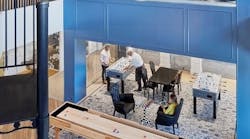At Design Connections last December, attendees had widespread response to an expert panel discussing the working styles of the varied generations that currently comprise the workforce, from baby boomers to millennials and Gen X in between.
which prioritizes on both group and individual work.
Ellucian: © Garrett Rowland
Just about six months later, i+s decided to touch base with panelists Kay Sargent, senior principal and director of workplace at HOK in Washington, D.C., and Osamu Osawa, technical designer for Gensler, also in D.C. Building off of the lively conversation at Design Connections that could’ve gone on for a few more hours, we asked them to break down some of the reasons why and how workplace design is influenced design by the multi-generational workforce.
Interiors+sources: How have you seen the workplace evolve during your time designing for the segment?
Kay Sarget: We work differently today than we did even five years ago. And in the coming five years we will work differently than we do today. In our rapidly changing world, we are more and more focused on designing for the unique attributes of people and organizations. At the end of the day people costs are 10 to 15 times the cost of space, so we need to focus on making spaces human-centric.
not only on environmental sustainability but also human sustainability and well-being.
Gensler Atlanta Office Expansion Space: © Nigel Marson
Osamu Osawa: I’ve been designing for the workplace segment for only few years now. However, in these past few years the workplace has indeed evolved but gradually. Workplace design is geared toward creativity and innovation which prioritizes on both individual and group work.
We are implementing this more often and generally the clients are open to this. The collaboration/social spaces have been more well received as it gives the staff time to be away from their desk. As an individual working in a creative office, I enjoy the social and collaboration spaces we have in our office as it gives me time to be away and interact with my colleagues. These coffee talks can fuel great ideas for the next design as is the case with our Gensler office.
Related: Workplace Design Matters
i+s: How has the workplace changed since millennials entered the workforce?
OO: Since I am considered a millennial, I have not personally experienced a workplace change. However, I can say that as an older millennial I have seen the influence we can have for the workplace. We bring new ideas and needs to the workplace force. We have seen many trends and innovation come and go during our time that has influenced the way we live daily which we bring into the workplace. Millennials tend to voice their opinions a lot more frequently than other generations, unafraid to put out their point. As the workforce continues to change, we will see more of the millennials’ opinions having a bigger impact.
gender, ethnicity, full-time/part-time schedules, and personality types all affect work styles,
and, therefore, workplace as well. Bracewell DC Photography Credits: © Michael Moran
KS: The arrival of the millennials coincided with advances in technology that untethered us from the workplace, hence enabling a rise in mobility. And with greater mobility comes a need to create more compelling spaces that draw people in, engage and empower them. There is also a new focus not only on environmental sustainability but also human sustainability and well-being.
i+s: What is different about the working styles (in terms of design) of boomers, Gen X, and millennials?
KS: Today’s inter-generational workforce is composed mostly of individuals born between 1945 and 1995, a 50-year span of unprecedented social and technological change. But as the millennials mature it’s noted that the differences between them and other generations aren’t as significant as thought and “life stages” actually have a bigger impact than generations. But workforce demographics aren’t solely about generations: gender, ethnicity, full-time/part-time schedules, and personality types all affect work styles, and, therefore, workplace as well. Understanding who you are designing for and their attributes and traits should all be factors in the design of your space.
OO: I think there is a misconception where people may think millennials are most likely to work away from the office if given the choice. This may be true for some, but the majority still believe working in an office is ideal rather than teleworking. I for myself feel more productive working in an office and feeding off of my colleagues’ vibes and motivation. It also provides me the collaborative resources that I can’t have if I work away or individually. Millennials including myself like to be in a collaborative environment, but also look to a place designed for concentration and focus.
Even more: Designing for Wellness


